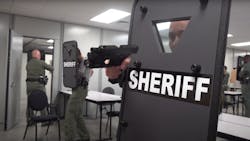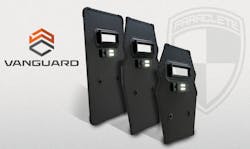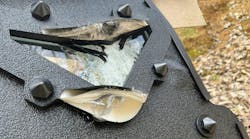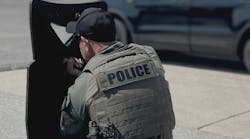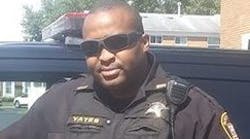Traditionally, ballistic shields have been used by SWAT teams and have oftentimes been bulky, with multiple officers needed to operate the shield in order to provide cover during an incident. As active shooter incidents at places like schools, malls and office buildings have become more prevalent, armor manufacturers have begun creating fighting shields that allow a single officer to hold the shield in one hand and a firearm in the other.
This article appeared in the January/February issue of OFFICER Magazine. Click Here to view the digital edition. Click Here to subscribe to OFFICER Magazine.
In November, the Hillsborough County Sheriff’s Office in Florida received its first shipment of Safariland ProTech Assault II VP ballistic shields for its school resource deputies. The shields are compact and weigh 20 pounds.
In order to cater to the needs of officers not normally working in a tactical capacity, manufacturers have gone to great lengths to improve the shape, size and weight of their ballistic shields. OFFICER Magazine recently spoke to representatives from Point Blank Enterprises and BlueRidge Armor about what goes into making a ballistic shield that works for both patrol and school resource officers.Evolution of ballistic shields
Historically, ballistic shields were commonly referred to as bunkers due to their large size and weight, often larger than 24” x 36” with very large rectangular viewports, heavy batteries for lighting systems and well north of 45 pounds, making them difficult to deploy by hand for any extended period of time. Material compositions used for various types of bunkers may have been ballistic steel, aluminum or heavy resin infused aramid composites and, in some cases, ceramic faced with aramid composite backing. Back in the 70s and 80s, bunkers were typically used in response to a specific call out in high-risk standoff situations and many agencies may have had only one, or a very limited number of bunkers, and even more limited deployment specialists due to their size and weight. In the early 90s, a new Ultra High Molecular Weight Polyethylene (UHMWPE) fiber was introduced into the armor market initially targeted at soft flexible armor promising reductions in weight by as much as 10%, compared to traditional woven aramids. UHMWPE quickly found its way into low- and high-pressure rigid composite applications, paving the way to modern day ballistic armor and shield designs. Today, single-hand deployable ballistic shields range in size from 15”x19” without a viewport up to 24”x48” shields with viewports and are typically tested to NIJ 0108.01 threat Level IIIA 9mm/44 Magnum, or threat Level III .308 M80 ball.
Tyrone Minton, Senior Director of Engineering–Hard Armor at The Protective Group (TPG), the hard armor division of Point Blank Enterprises, says that traditionally, a lot of ballistic shields were Kevlar-based. “These shields that SWAT teams were primarily using were bulky, thick and offered limited threat protection,” he says. “They were usually IIIA, so handgun rated. It’s just recently that we’ve started to see more rifle-rated shields being fielded. With the influx of rifle threats and people out there using rifles in their crimes, the need for a large coverage area rifle protection is really kind of what spurred the design and development on these newer rifle-rated shields.”
He stressed that the industry is approaching a kind of apex of material technology with what’s available for these threats. “As we start looking at moving to a new standard for ballistic requirements when the new NIJ 107 Standard comes out eventually, that is going to change how the threat categories are broken down,” he says. “The shield standards—there isn’t really a shield standard today—there is the NIJ 108, basically is just a generic armor panel testing spec. It is very weak in the sense that it doesn’t require much testing in order to say you were testing and in accordance with that requirement.” Point Blank has been heavily involved with ASTM in developing testing for new ballistic shields for law enforcement.
Dale Taylor, the founder of BlueRidge Armor, says his company develops its armored product offerings based on currently issued ballistic test methods and procedures. “In the case of our ballistic resistant shield and bunker development, we refer to NIJ 0108.01, Ballistic Resistant Protective Materials. NIJ 0108.01 is an equipment standard developed by the Law Enforcement Standards Laboratory of the National Bureau of Standards. In addition to the baseline performance requirements of specific Standard, we also look at commonly known street threats for an identified protection level in our shield development. For example, threat level IIIA of NIJ 0108.01 calls for baseline performance against two ballistic threats, 9mm 124gr. FMJ and 44 Magnum 240gr. SWC-GC. We may also test additional street threats such as 7.62x25 commonly known as a Tokarev pistol round or even a 12-gauge shotgun slug. In any case, these types of rounds or threats would be identified as ‘Special Threats’ which basically means ‘Additional Calibers and Specific projectiles’ outside the scope of a given standard.”
Taylor said that BlueRidge also has been involved with ASTM International in developing the new testing standard. “This new protocol has been in development over several years and has had a broad range of contributing input from law enforcement, armor manufacturers, independent ballistic test laboratories and ballistic expert statisticians,” he says. “Picking up where NIJ0108.01 left off, the new protocol adds commonly available street threats, formerly known as special threats, such as the 5.56 M193 and 7.62x39 MSC Type 56, along with the traditional heavy hitting 7.62x51 M80 ball.”
Repurposing technology
Michael Archibald, President of The Protective Group (TPG), says that since the Point Blank Enterprises does so much business with the United States Department of Defense, it has the ability to leverage that knowledge and technology when it comes to law enforcement products.
The Vanguard is Point Blank’s latest ballistic shield. “In the past, just over a year ago, our lightest weight 20”x30” ballistic rifle shield was the ASPIS at about 18 pounds,” says Archibald. “We went through an advanced development program with one of our aviation aerospace customers and we leveraged the best available technology.” From there, the company considered repurposing the technology used for the aircraft panel for a ballistic shield created for law enforcement. “We ran the numbers and we moved the needle from an 18-pound shield with the same kind of ballistic performance to now a 15-pound shield.”
From there, Point Blank invited partners who specialize in ballistic shield training to evaluate the shape. “Effectively, we moved from a shape in the ASPIS shield, which is basically an application for a team approach, to the Vanguard, which enables an officer to individually protect themselves with the ballistic shield and fight with a handheld weapon with improved stability and confidence.”
Archibald adds that the shape of the Vanguard was specifically designed for patrol. “It’s designed, both weight and shape, to stabilize.” He noted that there’s a notch included on each side toward the top of the shield, which has been designed for officers—righthanded or lefthanded—to be able to stabilize their weapon in one hand while wielding the shield in the other. “No one really asked for the Vanguard in the market, but when we put this aerospace panel that we tested extensively on a handheld shield at last year’s SHOT Show, everyone said ‘This is really great.’ This year we’ve refined the design and rolled it out and it’s gotten a lot of interest and huge amount of demand. We’re building a lot of those now for customers.”
Taylor agrees that evolving technology has been a driver for improvements in both ballistic performance and reductions in overall product weight and thickness, which can be seen in the BlueRidge’s new VENGEANCE X7. “New technologies in high performance fiber development, from companies such as Honeywell Advanced Materials, make their way into various ballistic fabrics and composite layers leading to reductions in weight that directly improves an officer’s ability to deploy armor,” he says. “Partnering with companies such as Elzetta Design, LLC, a manufacturer of high-performance LED lighting, introduces advancements in electronic circuitry and lumen output that contributes to improved visibility in low light tactical operations. In addition, the patented Elzetta Tridextrous grip and integrated shield light improves maneuverability during shield deployment.”Feedback from law enforcement
Taylor says that a high percentage of BlueRidge’s product design is developed with direct input from law enforcement personnel. “BlueRidge Armor hosts several training events each year from tactical officer association events to direct agency training,” he says. “These tactical training events give potential and current customers hands-on live fire experience with our hard armor ballistic shields. During these events, we strive to listen to the Voice Of the Customer (VOC) for ergonomic and functionality input on existing and newly developed product designs.”
He points out that a prime example of law enforcement feedback is the company’s VENGEANCE Series viewport which evolved over several meetings with a highly experienced shield deploying tactical unit. “Those meetings and critical feedback ultimately defined the overall features and performance characteristics of our VENGEANCE Series product line. This is where our tag line ‘Mission Driven—Purpose Built’ was derived.”
Archibald says that of the approximately 800,000 law enforcement officers in the United States, generally, about 100,000 are tactical and SWAT trained and about 700,00 are patrol. “We’ve moved to the Vanguard to specifically facilitate patrol officers to be able to operate this fighting shield, offensively as well as in a defensive position, on their own. It’s perfect for patrol officers in a squad car to be able to pull out of the trunk in an active shooter situation. It’s perfect for school resource officers to be able to respond on an individual basis to an active shooter event. Because it’s so much lighter than in the past and it provides so much protection, I think that it’s really going to enable patrol officers across the nation to be safer in dealing with these special kind of active shooter events.”
He says that the other key feedback Point Blank has received from is that officers are much more diverse than they’ve ever been. “You’ve got smaller statured officers. That can be female or people from different parts of the country that might not be as large as typical tactical SWAT people,” he says. “We want to be a very helpful and critical safety item for these officers to be able to engage during these kinds of activities than they have been able to in the past.”
This article appeared in the January/February issue of OFFICER Magazine.

